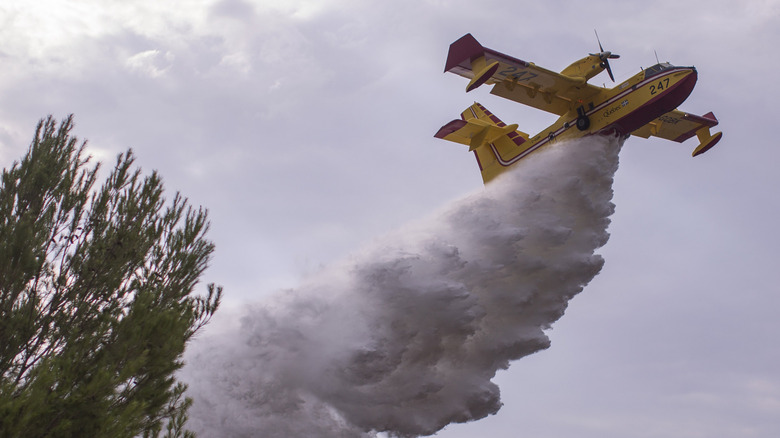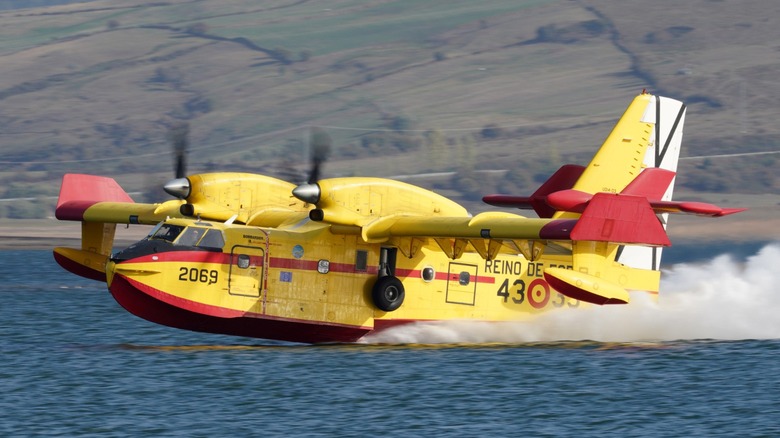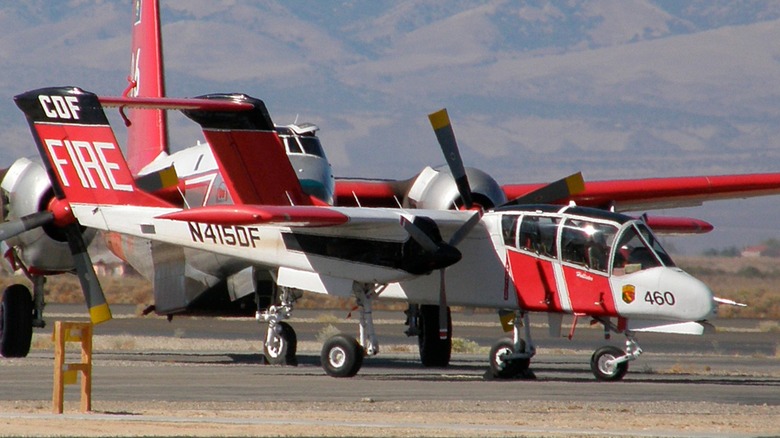How Many Gallons Of Water Does A Firefighting Plane Hold?
Wildfires can start anywhere, anytime, but usually happen during the hotter, drier months. What makes them dangerous is how fast flames travel — up to 14 miles an hour. That's why wildfires can cover large areas, sometimes burning thousands of acres. For example, the 2025 Palisades Fire consumed over 23,000 acres, while the nearby Eaton Fire enveloped 14,000 acres.
So firefighters had to use a lot of water to help stop the flames from spreading. Most pumper fire trucks only carry 500 to 1,000 gallons, so they must connect to a fire hydrant for a continuous supply. On the other hand, tanker trucks, built for carrying water or other fire retardants, usually have 3,000 gallons or more. While this might look like a lot, one or even 10 fire trucks are not enough to control a wildfire.
This is where firefighting planes and helicopters come in. These specially designed aircraft are built to control a fire's spread or help steer it away from populated places. Furthermore, they let firefighters reach in remote areas, especially places without easy road access. Rather than water, most carry fire retardant, which crews load onto the plane at air bases. So after an aircraft drops its retardant load, it must land back at an airport to refill its tank. On the other hand, some firefighting planes and choppers get water from lakes and other nearby sources. This makes them easier to reload and lets them dump more water on a fire much more quickly.
Firefighting planes carry water or fire retardant
The U.S. Department of Agriculture's Fire Service lists planes that carry and drop water or fire retardant in four categories: Single-Engine Airtankers, Large Airtankers, Very Large Airtankers, and Water Scoopers. Single-engine airtankers are the smallest firefighting planes, and there's just one model — the Air Tractor AT802 Fire Boss. This seaplane is also a Water Scooper, getting water through nozzles on its floats to fill its 820-gallon water tank.
Large Airtankers mostly carry fire retardant. They include converted C-130s with 4,000-gallon tanks and old airliners, like the MD-87 Fire Bomber and the four-engine BAe 146-200, both of which can carry 3,000 gallons, as well as the P2V, HC-130H, and RJ85. The California Department of Forestry and Fire Protection also operates former U.S. Navy anti-submarine carrier aircraft Grumman S-2 Trackers, now converted to firefighting use, with a capacity of 1,200 gallons of retardant. But the Canadair CL-415 SuperScooper, a Water Scooper and one of the strangest emergency vehicles ever built, also falls into this category, with its capacity of 1,600 gallons of water.
Very Large Airtankers are the big guns of firefighting aircraft. The largest currently in operation is the DC-10, a converted three-engine airliner based on the McDonnell Douglas DC-10 jet, with a huge tank that carries 11,600 gallons of fire retardant. Up until 2021, the biggest was a converted Boeing 747 that carried 18,000 gallons of retardant, but it was retired from service.
Other firefighting aircraft
Airplanes aren't the only aircraft that firefighters use. There also are firefighting helicopters, which also pick up water, and are crucial for combating smaller fires. They can deploy firefighters at locations inaccessible to ground vehicles and evacuate both fire personnel and civilians from danger areas. California's Department of Forestry and Fire Protection operates several Bell UH-1H Super Huey and Sikorsky S70i Black Hawk choppers to combat fire, both of which are among the most iconic military helicopters in history. The Super Hueys can carry 320 gallons of water in dangling buckets, and the Black Hawks can carry water or retardant.
There are also tactical planes used for coordinating the entire operation. These eyes-in-the-sky units help ensure that everyone has a big picture of what's going on, and can command tanker planes to make drops where they're needed the most. For this task, California uses OV-10 Broncos, previously among the most notable aircraft to fly during the Vietnam War, when they were deployed as forward observer aircraft. Some large and very large tankers use their own planes and teams to help with firefighting, though, so you might see other non-tanker aircraft operating over wildfires.


